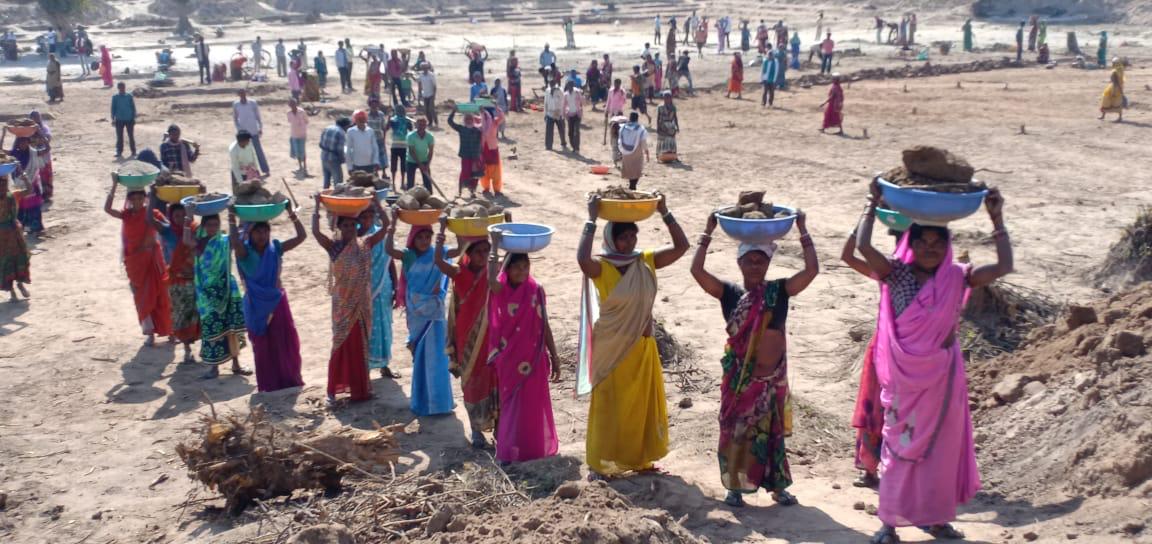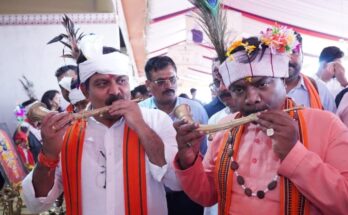Article: Shashiratna Parashar
Mahasamund 21 December 2020. Despite the formation of the state of Chhattisgarh, the natives and residents here could not get the benefits of development which they were rightfully entitled to. The declining groundwater level, increased cost of cultivation, fodder crisis for cattle, etc. made the situation more frightening. Since the formation of the new government in the end of the year 2018, this Chhattisgarh has changed so much that the principles of Gandhi have started running.
Chief Minister Shri Bhupesh Baghel gave the slogan as soon as he took over the power of the state – four symbols of Chhattisgarh are Narva, Garuva, Ghurwa and Bari Ella Bachao hai Sangwari (There are four symbols for identification of Chhattisgarh, Narva (Nala), Garwa (Animals and Gothan), Ghurava (fertilizer) and Bari (garden), their preservation is necessary. Through this scheme, help in ground water recharge, irrigation and organic farming, the farmer was able to take a double crop. Ensured proper care of the animals. Traditional The kitchen garden and rural economy have been strengthened and nutrition levels have also seen improvement. Now we are returning to the work of preserving the ancient culture and concerns.
Talking of Mahasamund district under Narva, Garuva, Ghurwa and Bari, the ambitious plan of Chhattisgarh government, 65 Gothan were allowed to be built here in the first phase. The number of which has now increased to more than 300. Out of which 175 Gothan have been completed. 34 Gothan is in progress. There are 17 Adarsh Gauthans in the district. Under the Garuva program, cattle have been sheltered from the formation of Gothan in Gram Panchayat of Mahasamund district and now the variance of cattle on the roads has reduced. The Gauthan Management Committee has been selected at the village level for proper management and maintenance of fodder grains as well as cattle by the villagers in Gauthan, by whom Gauthan has started operations. In which the management of animal remains is done in a scientific manner to prepare modern manure from cow dung, Various types of economic activity have been conducted at the site of preparing pesticides from cow-urine. Due to the operation of the Gauthan by the members of the Village Gowthan Management Committee, the cattle are now collected in a systematic manner. Farmers are also assured that the crops are safe from cattle and accidents have also come down.
This scheme is applicable across the state. Help for MGNREGA is being provided to plant the fence, while self-help groups are being assisted by women and social welfare. The villagers themselves are helping out. The problem of stray cattle is decreasing in the villages, so the farmer is also excited and eager to plant the second and third crops.
Women self-help groups and youth of the village are being linked to this scheme. This scheme will not require encircling the fields to save crops from animals. While organic manure is being available to the farmers, the agricultural cost has also come down. People should also get employment opportunities. In the first phase, construction of two thousand Gothanas has been approved. Currently their number has been increased. Talking about Mahasamund district, 65 Gothans were constructed in the first phase, whose number has increased to more than 300. There are 17 Adarsh Gauthans in the district.
Under the scheme, para-donations are also being made voluntarily for the Gothan by farmers of villages around Garuva. Tractors filled with paras can be seen coming from the Gothans. This work of farmers is being appreciated. The Badi scheme promotes the production of vegetables and seasonal fruits in the farmyard of farmers’ homes. It is providing nutritious food. At the same time, green vegetable-vegetable was prepared by the children in the kitchen garden on the vacant land of Shala-Ashrams, Anganwadi centers. These institutions are currently closed due to nationwide lockdown.
At present, 46.55 lakh man days have been achieved against the total target of 67.73 lakh man days in the financial year 2020-21, which is 68 percent more than the target. About 2.50 lakh laborers from more than one lakh 20 thousand families were provided employment under MNREGA in the district. 9471.58 lakhs was spent. Of this, 8287.92 lakhs have been spent on Majdari and Rs 1183.66 lakhs on materials.
The government’s ambitious scheme State Rural Livelihood Mission has 5223 women self-help groups working in Mahasamund district. In this, more than 55 thousand women are becoming self-sufficient by making different types of materials, from candle, lamp, washing powder to pickle, elder, papad etc. according to the local market demand.




